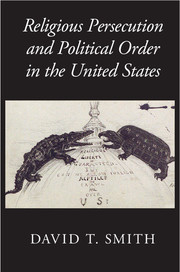Book contents
- Frontmatter
- Dedication
- Contents
- Acknowledgments
- 1 Introduction
- 2 Religious freedom and persecution in America: A theoretical overview
- 3 Joseph Smith and the rise of Mormonism: The political threat of religious charisma
- 4 The federal response to Mormonism
- 5 Jehovah's Witnesses and the flag salute, 1870–1940
- 6 Mass violence against Jehovah's Witnesses, 1940–1942
- 7 The Catholic experience in America
- 8 The Jewish experience in America
- 9 The Islamic experience in America
- 10 Conclusion
- Sources and bibliography
- Index
1 - Introduction
Published online by Cambridge University Press: 05 November 2015
- Frontmatter
- Dedication
- Contents
- Acknowledgments
- 1 Introduction
- 2 Religious freedom and persecution in America: A theoretical overview
- 3 Joseph Smith and the rise of Mormonism: The political threat of religious charisma
- 4 The federal response to Mormonism
- 5 Jehovah's Witnesses and the flag salute, 1870–1940
- 6 Mass violence against Jehovah's Witnesses, 1940–1942
- 7 The Catholic experience in America
- 8 The Jewish experience in America
- 9 The Islamic experience in America
- 10 Conclusion
- Sources and bibliography
- Index
Summary
THE PUZZLE OF AMERICAN RELIGIOUS PERSECUTION
In the nineteenth century the Mormons were driven out of four states. In Missouri, the third state in which the Mormons settled, their neighbors declared war on them in 1838 when they seemed close to gaining a numerical majority in three counties. The ensuing skirmishes and massacres only ended when Governor Lilburn Boggs declared Mormons enemies of the state and issued an “extermination order” that forced them to flee to Illinois. In Illinois the state government initially welcomed the Mormons, but the reception soured by 1844, when local militias grew alarmed by Joseph Smith's increasing political and military power in the city of Nauvoo. On the pretext of defending free speech, an anti-Mormon mob lynched Smith when he destroyed a Nauvoo printing press that had denounced him. After the Mormons fled to Utah in 1847, the federal government fought for decades to break Mormon political power in the territory. Republicans had vowed to abolish Mormon polygamy in the west, and in 1883 Congress passed legislation stripping Mormons of the right to vote, hold political office, or serve on juries. Even harsher legislation in 1887 allowed the federal government to seize church property, including temples. The long campaign against the Mormons eased only after their leaders capitulated on the polygamy issue and forcibly realigned Mormon voters to the Republican Party.
In the late 1930s, elementary schools across the United States expelled thousands of children of Jehovah's Witnesses who refused to salute the American flag during the daily pledge of allegiance. In 1940, the Supreme Court ruled that school districts were within their rights to expel Witnesses, whose religious freedom did not include the right to disrupt the national unity the flag salute promoted. The flag conflict escalated into public violence as the Second World War approached and citizens questioned the loyalty of Jehovah's Witnesses. In small towns in every state, mobs attacked Witnesses while they proselytized. There were more than two thousand violent anti-Witness incidents between 1940 and 1942, many of which involved police, sheriff's departments, and other local authorities. Despite the repeated pleas of Jehovah's Witnesses and the ACLU, the federal government took little action to prevent the violence. The attacks only subsided when the draft came into effect and the government began imprisoning large numbers of Witnesses who refused to enter it.
- Type
- Chapter
- Information
- Publisher: Cambridge University PressPrint publication year: 2015



